Research Article - (2022) Volume 12, Issue 3
Vegetation and landscape dynamics of the Guerbes-Benazouz dune cordon in Skikda, Algeria
B. Kamel-Eddine*Abstract
The coastal dunes of Guerbès region in eastern Algeria, are protected by typical Mediterranean plant cover, including Diotis maritima, Ammophila arenaria, Retama boveï, Juniperus oxycedrus, Quercus coccifera, Alnus glutinosa, Pistacia lentiscus, and Quercus suber. This vegetation cover is threatened by intense anthropic activities such as clearing, cutting, fire, grazing, and construction, which result in bare land exposed to wind dynamics from the prevailing northwesterly winds. In 2018, the amount of sand transport reached a maximum during the winter season, with a rate of 768.12 g/m/s. The results of this study suggest that biological fixation of the dune cordon via the introduction of Retama boveï is required to stabilize the moving sands, as well as to combat all forms of degradation, and the negative impacts of human activities.
Keywords
Guerbès, Eastern Algeria, Coastal dunes, Vegetation cover, Wind dynamics, Ecological degradation.
Introduction
In Algeria, the growth of rural populations in fragile environments has lead to the degradation of non-renewable or barely renewable resources, such as forests, soils, and water (Oldache El-hadi, 2021). This process is accelerating because of overgrazing, overexploitation of crops, poor irrigation methods, deforestation, and increasingly severe climatic conditions (Wael El Zerey, 2014). Moreover, drastic and rapid changes in recent decades have increased the risk of some global ecosystems disappearing entirely (Tayeb, S. and Khéloufi, B. 2008). Such disturbances of biological resources are observed on the dune cordon of Guerbès-Benazouz, in eastern Algeria (Bazri, 1999).
Marta et al., (2020) state that evidence of large, often non-random, taxonomic and functional changes occurring in Mediterranean coastal dune plant communities in a surprisingly short time-span. This, together with the disappearance of c. 23% of historical plots and with substantial losses in focal species, suggests that intense degradation processes are occurring in coastal dune habitats, particularly on the upper beach and on shifting dunes.
Acosta et al., (2007) declared in their study on the description of the vegetation zonation and its relationship with dune local morphology through the application of a randomization test on some sandy ecosystems of the Italian Mediterranean coast, that In well-preserved dune ecosystems, it is assumed that typical dune vegetation zonation is closely related to the geomorphological and sedimenthological features of dune systems (Fenu et al., 2003; Carter and Wilson, 1990).
Many disturbance factors affect European coastal ecosystems (Van Der Maarel, 2003). More specifically, coastal erosion, agriculture, urban development, and tourist pressure should be mentioned for the Italian coast (Acosta et al., 2003; Géhu and Biondi, 1994a). Coastal sand dunes have been identified as being particularly susceptible to destabilization through visitor pressure, which has increased dramatically in the last 50 years (Curr et al., 2000).
In this study, we discuss the relationship between humans and the environment in the Guerbès-Benazouz region in eastern Algeria, which is a physical environment with considerable natural and agricultural potential for local, regional, and national economic development. Specifically, this region boasts high-yield farmland, significant water resources, remarkable vegetation cover (forests and scrub), a coastal landscape, mountainous environments, a large dune cordon, as well as expanses of lakes and marshes. This area is also classified as a wetland by the Ramsar Convention. In addition, population is predominantly rural, and the main industry is agriculture on the dune cordon and the plain of Benazouz, where irrigation and groundwater is provided by the Kebir West River. These combined factors have favored strong demographic growth in the study area. However, the physical environment of Guerbès-Benazouz is highly fragile, particularly the vegetation cover, which is currently undergoing continuous anthropogenic transformation through fires, clearing, plowing, overgrazing, construction, and urbanization. Moreover, the coastal dunes are exposed to strong wind dynamics, which threaten the roads, villages, and economic stability of the Benazouz plain. Thus, this study aims to visualize the dynamics of the vegetation of the dune ridge of the study area. We then propose measures for the restoration and conservation of these fragile environments toward a more sustainable future development.
Methodology
To achieve the objective of this study, we reviewed previous literature on the geological, geomorphological, pedological, and phytoecological features of the study area. We also performed a field survey in 2018-2019 to describe the vegetation types, plant groups, and their spatial distribution, and quantify the changes in vegetation dynamics previously determined by Thomas (1975) for the coastal dunes of eastern Algeria. Here, We carried out floristic samples, using the Braun-Blanquet (1951) scale based on the coefficient of abundance and dominance of plant species at the site studied, according to a NW-SE transect from the beach to the interior of the Benazouz plain, over a length of 13 km, with an estimate of the rate of vegetation cover (just vascular plants) in 11 stations: Kef Fatima (S6), Demnet attaoua (S8), Aïn Berda (S9), Kef Siada (S10), Boukout Sisig (S11), AïnRas El Oued (S12), Koudiat El Mroudj (S13), Mrabet Aïcha (S14), Machtat Ramdane (S15), Chikh Ben, Mokrane (S16) and Koudiat Safra (S17), on the dune strip, and 06 stations in the surrounding area (Djebel Filfila (S1, S2, S3), Dem El Bagrat (S4), Dem Safsaf (S5), Oued Dissia (S7), As shown in Fig. 1. The plant species were identified according to the nomenclature of Quézel, P. and Santa, S. (1962-1963).
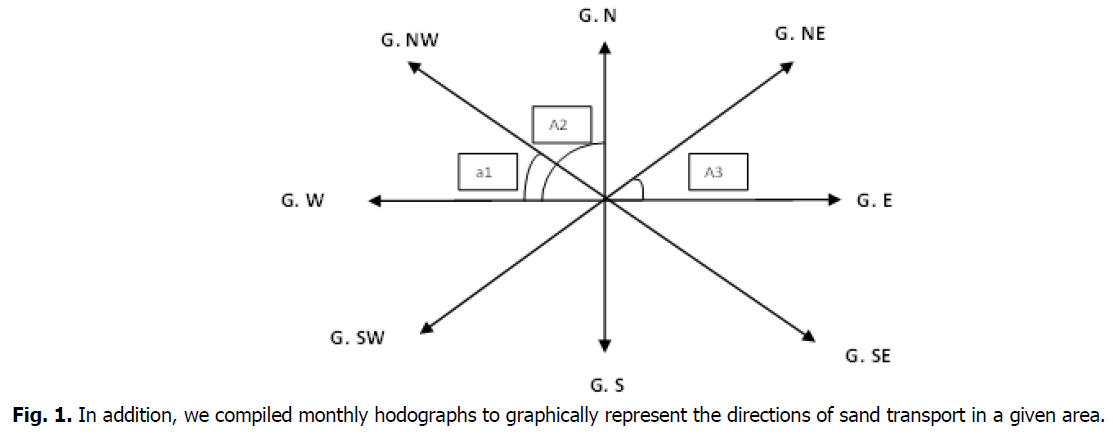
Fig 1: In addition, we compiled monthly hodographs to graphically represent the directions of sand transport in a given area.
We also analyzed the anthropogenic factors responsible for the degradation of the dune cordon through the number of offenses recorded by the forest conservation and environmental services of the municipality of Ben Azouz, and observed the impacts on the vegetation and the dynamics of the wind.
To better explain the wind dynamics, we estimated the amount of sand transported by prevailing winds on the dune ridge using previously described methods based on wind speed and the sine of the incident angle of the prevailing wind using the method of Zakirov (1983) in (Svintsov, I., 1986), who proposed the following formula:
G=0.10 x (Vg-5.4)3 t
G=The quantity of sand transported in g/m, for the period of action of the wind (t)
Vg=Wind speed at height 10 m
For the transport of sand by a wind oblique to the object to be protected, the quantity of sand transported is:
Q=G x sin (a)
G=total sand flow
a=the angle of attack
For the transport of sand by winds from several directions towards the object to be protected, the quantity of sand transported is represented by the sum of the quantities carried by the winds concerned.
Example: Calculation of sand transport towards protection line A-B, by winds from the northern sector:
Q=(G, NW x sin1)+(G,N x sin a2)+(G, NE x sin a3)
Study area
Geographical location
The study area belongs to the Guerbès-Benazouz wetland complex in eastern Algeria, which is located approximately 30 km from the east of Skikda Province, between 36°N, 7°E and 37°N, 7°E (Fig. 2). This area is dominated by the vast plain of Sanhadja and is drained by the Kebir West River, which extends for more than 20 km and is impeded from reaching the sea by gentle slopes that range from 0% to 4% over the entire terrain; this promotes the formation of local hydromorphic depressions called “garaats.”
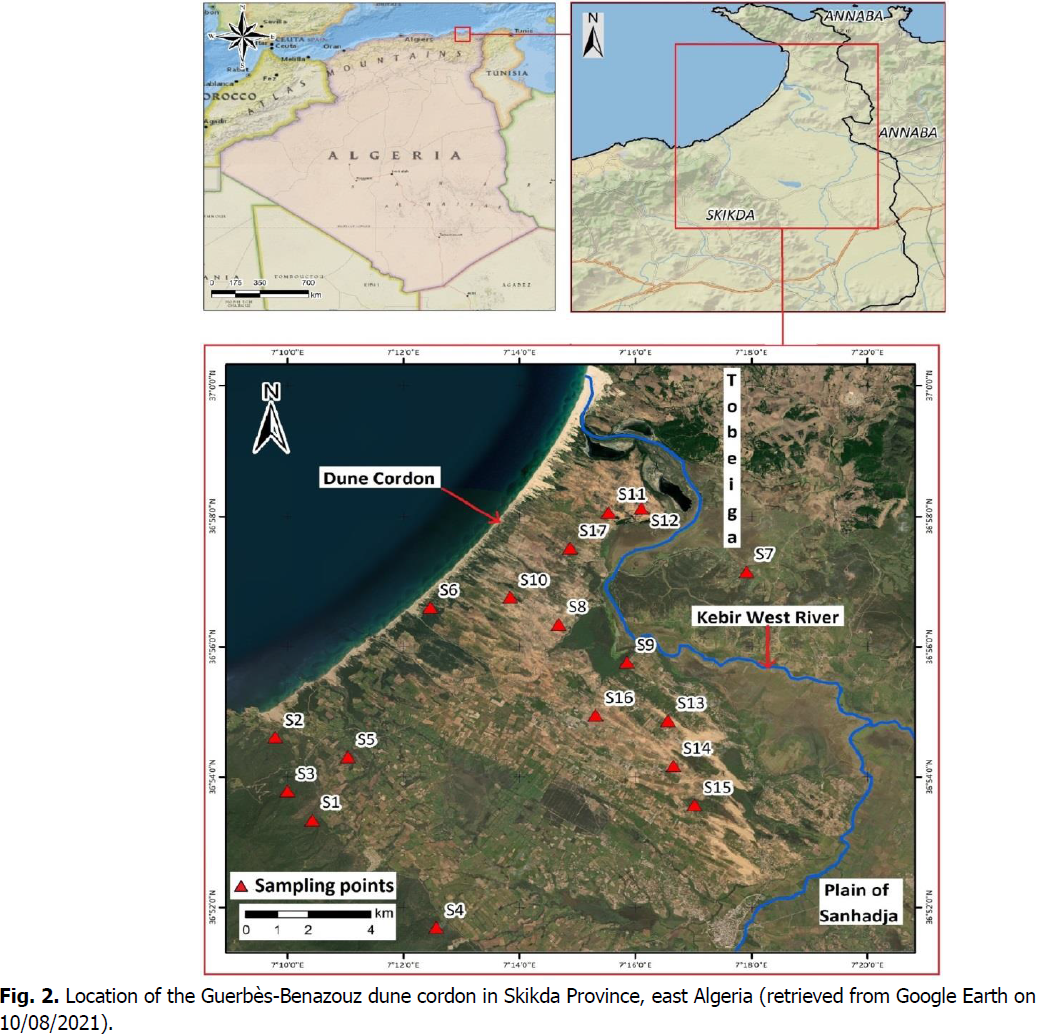
Fig 2: Location of the Guerbès-Benazouz dune cordon in Skikda Province, east Algeria (retrieved from Google Earth on 10/08/2021).
The study area is approximately 14,000 ha, 79.2% of which is plains and dune cordons (Bazri, 1999). A dune complex approximately 13 km long extends from the coast to the interior of the plain, and has an elongated form owing to the prevailing NW winds. The width of the dune occupies the plain from east to west. Dune altitudes vary from 20 m to 110 m (at Boukout Sisig), and generally decrease from NW to SE (Fig. 3).
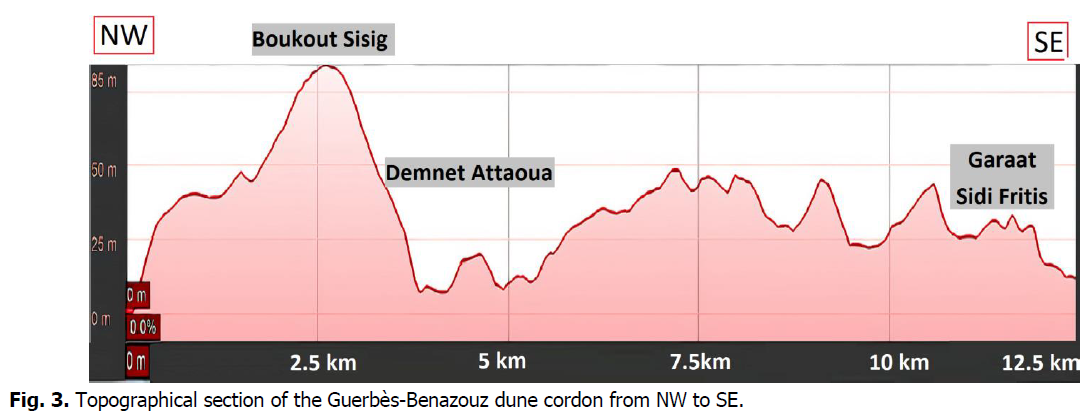
Fig 3: Topographical section of the Guerbès-Benazouz dune cordon from NW to SE.
Ecological characteristics
According to Bazri (2009), secondary and tertiary geological systems dominate the terrain overlooking the Benazouz plain. The marine quaternary unit is predominantly dune formations. However, continental quaternary formations dominate the plains and valleys of the Kebir West River (Joleaud, 1912; Durand, 1952). The soil units characterizing the study area are grouped into four soil classes. Undeveloped and poorly evolved mineral soils characterize the dune complex, whereas browned and hydromorphic soils represent the plain and valley of the Kebir West River. These four soil classes belong to the sandy soil series, which explains the fragility of the study area.
As a coastal region, the study area receives annual rainfall of 800-1,000 mm; however, neighboring altitudes receive 1,000 to 1,200 mm of annual rainfall (Merniz et al., 2019). The seasonal characteristics follow an WAS-type regime (Winter, Autumn, Spring). That is, the second minimum rainfall occurs in spring, and the first maximum rainfall occurs in autumn. The wettest season is winter, and the driest season is summer. Wind strength values exhibit minimal variation throughout the year, and are typically low to moderate; the two most common wind speed classes are 6-10 m/s and 11-15 m/s (Fig. 4). The maximum wind speed is typically greater than >36 m/s in winter (Fig. 5).
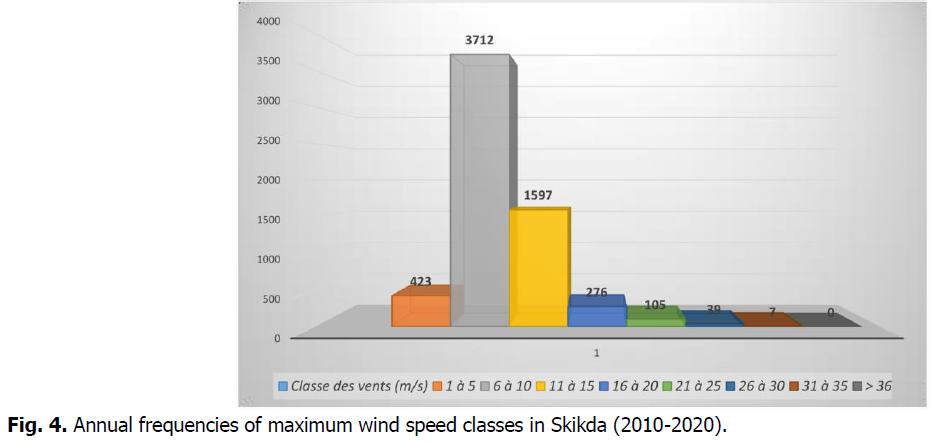
Fig 4: Annual frequencies of maximum wind speed classes in Skikda (2010-2020).
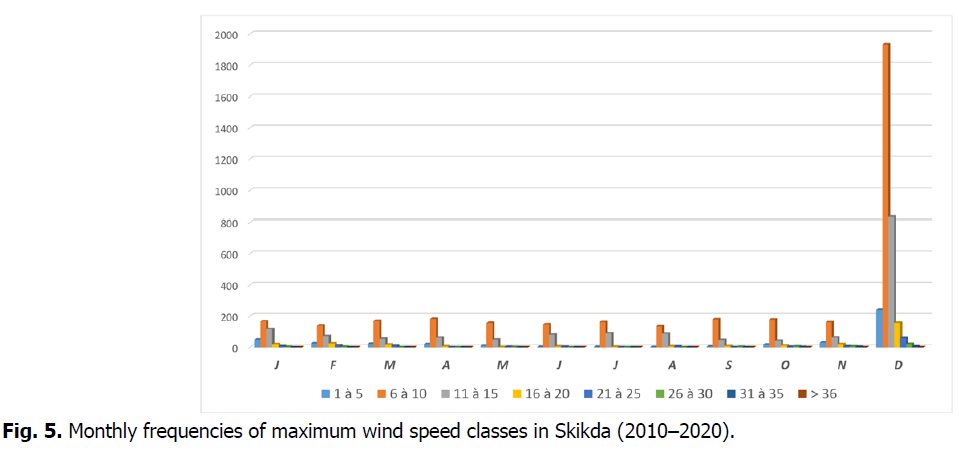
Fig 5: Monthly frequencies of maximum wind speed classes in Skikda (2010–2020).
Regarding the ecological stability of the study area, previous analysis conducted by Bazri (1999) revealed that it is characterized by fragile environments, particularly in the foothills of the Tobeiga mountains in the northeast of the study area and in the dune cordon (Annex 1).
Results
Vegetation zones
The data in Annex 2 and Annex 3 obtained from vegetation surveys in the study area show that the vegetation landscape in the Guerbès region is dominated by the following five types.
a) Matorrals composed of Cistus monspeliensis or Pistatcia lentiscus and Olea europea, typically observed at Djebel Filfila, Aïn El Berda, Oued Dissia, Kef Siada, and Koudiat El Mroudj stations, with a typical coverage rate of less than 75%.
b) Scrubland composed of Quercus coccifera and Pistacia lentiscus, typically observed at Mrabet Aïcha and Kef Fatima stations, with a coverage rate of 25-50%.
c) Scrubland composed of Halimium halimifolium and Calycotome spinosa, typically observed at Mechtat Ramdane and Chikh Ben Mokran stations, with a coverage rate of less than 25%.
d) Erme of Euphorbia paralios and bare soil, typically observed at Mechtat Aïn Charchar and Ghout Eddis stations, with significantly degraded vegetation cover.
e) The forest itself is composed of Quercus suber, which is almost completely degraded and burned, and distinguished from the surrounding terrain at the level of Djebel Filfila, Dem El Bagrat, Dem Safsaf, Oued Siada, and Demnet El Attaoua stations.
Fig. 6 describes the distribution of vegetation cover from NW to SE on the dune cordon, which is described in the following subsections.
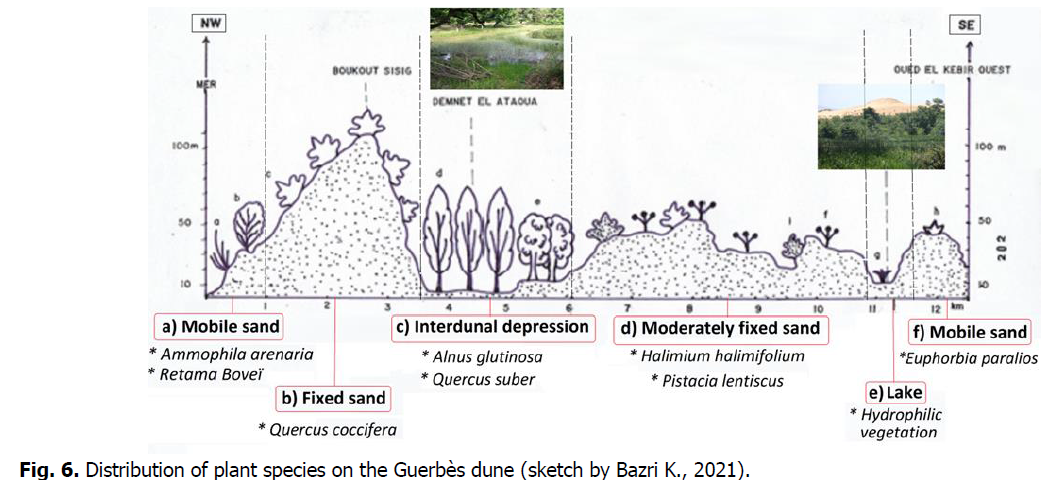
Fig 6: Distribution of plant species on the Guerbès dune (sketch by Bazri K., 2021).
Vegetation in the littoral part of the dune cordon
This vegetation zone exhibits poor edaphic environments, and is typically observed at Aïn Ras El Oued, Koudiat Safra, and Kef Fatima stations. This zone is dominated by the following species: Diotis maritima, Euphorbia paralios, Medicago marina, Agropyron junceum, Ammophila arenaria, Glaucium flavum, Echinophora spinosa, Spergularia marginata, Salsola kali, Anthemis maritima, Lotus creticus, Echium confusum, Sporobolus arenarius, and Reichardia picroides. These species represent 25-50% of ground cover and dominate the first line of major dunes facing the sea. Reichardia picroides, Reseda alba, and Scabiosa rutifolia are also observed.
Slightly behind these littoral stations, Crucianella maritima, Pancratium maritimum, Rumex aristidis, Silene colorada, Centaurea sphaerocephala, Cutandia maritima, Cyperus kalli, Reseda alba, Scabiosa rutifolia, Linaria flava, Pistacia lentiscus, Juniperus oxycedrus, Juniperus phoenicea, and Rhamnus alaternus are observed. Notably, the species Retama boveïis widespread from the littoral stations toward the interior dunes, at Aïn Ras El Oued, KoudiatSafra, MrabetAïcha, Kef Fatima, Machtat Ramdane, Chikh Ben Mokrane, Koudiat El Mroudj, and Aïn Berda stations (Fig. 7).
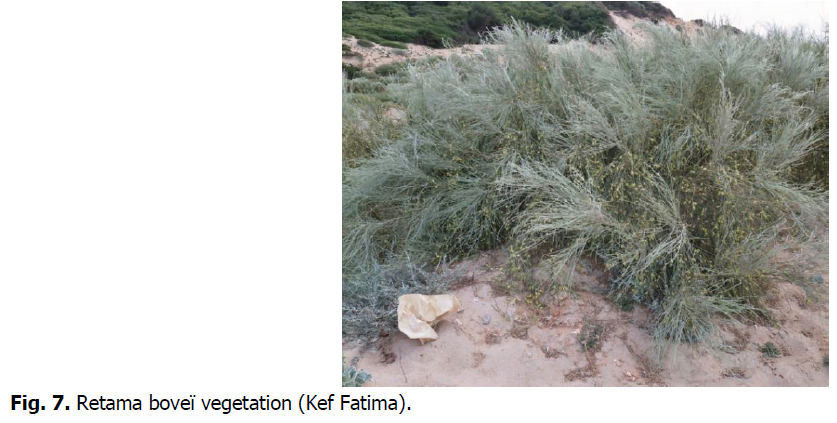
Fig 7: Retama boveï vegetation (Kef Fatima).
Vegetation in the northern part of the dune cordon
Here, the sandy substrate is fixed by vegetation dominated by Quercus coccifera, with a coverage rate of 50-75% at Boukout Sisig and Koudiat Safra stations. The species recorded at these stations include Quercus coccifera, Juniperus oxycedrus, Juniperus phoenicea Pistacia lentiscus, Chamaerops humilis, Halimium halimipholium, Calycotome spinosa, Calycotome villosa, Cistus salvifolius, Phyllirea angustifolia, Rhamnus alaternus, Genista ulicina, Erica arborea, Daphne gnidium, and Smilax aspera.
Vegetation in the southern part of the dune cordon
At Chikh Ben Mokrane and Machtat Ramdane stations, located in the south of the dune cordon, the vegetation cover is less than 25%. Halimium halimipholium is the dominant species, and constitutes a real degradation facies on fixed dunes. Pistacia lentiscus and Phyllirea angustifolia are also observed, as well as Chamaerops humilis, Halimium halimipholium, Calycotome spinosa, Calycotome villosa, Cistus salvifolius, Rhamnus alaternus, Genista ulicina, Erica arborea, Daphne gnidium, Smilax aspera, Quercus coccifera, Juniperus oxycedrus, and Juniperus phoenicea. Degradation is intense in this zone because of the sparse rural population (Fig. 8).
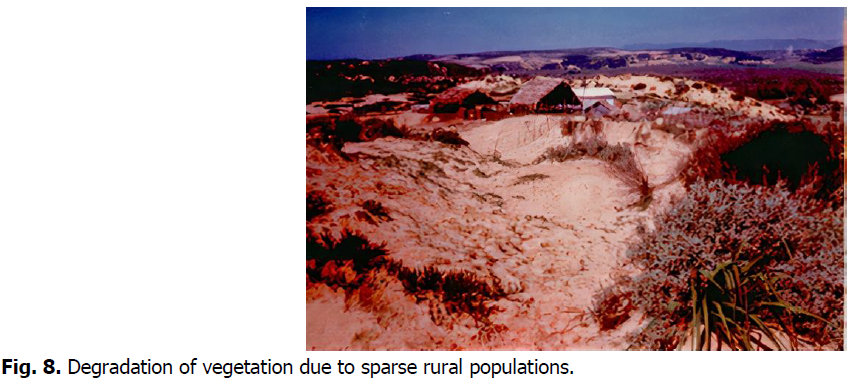
Fig 8: Degradation of vegetation due to sparse rural populations.
Vegetation in the interdunal depressions
In the large interdunal depression of the dune cordon (Demnet El-Ataoua), we witness wetland vegetation dominated by Alnus glutinosa, which reflects the wet climatic conditions of the Guerbès region (Fig. 6). On the edges of this alder grove, we observe very old cork oak (Quercus suber) trees, which are evidence of old cork oak forests. The degradation of cork oak is very advanced and marked by intense exploitation (clearing and fires). The presence of Pteris aquilina and Iris pseudo-acorus species reflects the cool temperature conditions of this zone.
To the south of the dune cordon, an interdunal depression fed by springs from the water annex, which is often waterlogged for long periods of the year, consists of Heleocharis palustris, Callitriche palustris, Mentha rotundifolia, Mentha pulegium, and Rumex conglomeratus. The following species occur adjacent to these lacustrine areas: Erica scoparia, Genista ferox, Halimium halimifolium, Chamaerops humilis, Calycotome spinosa, and Rosa sempervirens.
Mountains and foothills
Vegetation observed at stations in the mountains and foothills (i.e., Djebel Filfila, Dem El Bagrat, Dem Esafsaf, and Oued Siada) is predominantly settled, degraded forests comprising Quercus suber and other species such as Cistus monspeliensis, Cistus salvifolius, Tuberaria vulgaris, Calycotome villosa, Calycotome spinosa, Genista ulicina, Erica arborea, and Lavandula stoechas. Pistacia lentiscus, Phillyrea angustifolia, Olea europea, and Quercus coccifera are also observed. However, the mattoral vegetation observed at Aïn El Berda, Oued Dissia, Kef Siada, and Koudiat El Mroudj stations includes the following species: Pistacia lentiscus and Myrtus communis. Cistus salvifolius, Daphne gnidium, Bellis silvestris, and Cyclamen africanum, Mentha pullegium, and Genista ferox.
Vegetation changes in the dune landscape
The floristic inventory and estimation of the rate of plant cover across the dune ridge shows that vegetation degradation is clearly observed in this fragile environment composed of siliceous soils, which was formerly covered with extensive Quercus coccifera and Quercus suber scrubland on the plain. Currently, this area is experiencing severe anthropogenic degradation and deterioration toward bushes, scrubs, and bare sandy soils, which are more exposed to the action of erosive agents.
Discussion
The study area of Guerbès is characterized by minimal evolution of undeveloped and poorly developed mineral soils (Bazri, 1999), which explains the fragility of the physical environment reported in several previous studies (Hilly, 1957; Villa, 1982). The results of the vegetation sampling and field survey performed in this study agree with those of Thomas (1975) and Aouadi (1989), which were also conducted on the eastern Algerian coast. Therefore, we identify the following vegetation groups in the study area.
Mobile sand dune vegetation groups
Diotis maritima group
This group colonizes the poorly edaphic environment (Chergui et al., 2009), supports saline ground, and exhibits adaptations to fight silting. The relevant species are Diotis maritima, Euphorbia paralios, and Medicago marina. These geophytes are responsible for the formation of elongated sand mounds in the prevailing wind direction. Rhizomes and stolons such as Agropyron junceum are considered to be anatomical structures best suited to silting and the colonization of bare ground, as they are efficient builders of small dunes, where the following species are established: Ammophila arenaria, Diotis maritima, Medicago marina, all of which are excellent sand-colonizing species (Paskoff, 2005). Hemicryptophytes with large vertical roots are also present in the Ammophila arenaria group, including Glaucium flavum, Echinophora spinosa, and Spergularia marginata.
Ammophila arenaria group
This group occupies mobile sands where Agropyron junceum competes with Ammophila arenaria, a more powerful species that allows the formation and fixation of a larger sand surface. This grouping constitutes the dominant vegetation cover on the first line of the key dunes facing the sea. It contains the following species: Salsola kali, Diotis maritima, Euphorbia paralios, Anthemis maritima, Lotus creticus, Echium confusum, Sporobolus arenarius, Reichardia picroides, and Medicago marina.
Other species that tolerate a substantial thickness of dry sand include Echiniphora spinosa, Reichardia picroides, Reseda alba, and Scabiosa rutifolia. Medicago marina and Lotus creticus (papilionaceous species) appear to be better colonizers of dune sands, as indicated by Khalil and Belabed (1999).
Retama boveï group
Retama boveï dominates in locations where the sands are enriched in organic matter. This species is characterized by substantial resistance to silting and heaving according to Boulila, F. et al., (2009), who also confirmed that Retama species grow in different ecological climatic areas of northeastern Algeria thanks to their ability to fix nitrogen and withstand poor environments. Crucianella maritima, Pancratium maritimum, Rumex aristidis (a species characteristic of fixed sands), Silene colorada, Centaurea sphaerocephala, Cutandia maritima, Cyperus kalli, Reseda alba, Scabiosa rutifolia, Linaria flava, and Ononis diffusa (more continental species) occur in this group. In the oldest areas stabilized by Retama boveï, several pioneer species of fixed dune groups are observed, including Pistacia lentiscus, Juniperus oxycedrus, Juniperus phoenicea, and Rhamnus alaternus.
Fixed sand dune vegetation groups
Here, kermes oak (Quercus coccifera) can effectively adapt to deep sandy soils by participating in the fixation of sand, and ensuring a transition between living dunes and dunes fixed by Quercus suber. Halimium halimipholium is dominant over other species and constitutes a degradation facies on fixed dunes. Hébrard (1977) and Guo Yu Qiu et al., (2004) stated that the morphology and physiology of this species allows it to colonize degraded dunes.
The phanerophytes encountered in fixed sand dunes are Pistacia lentiscus, Chamaerops humilis, Halimium halimipholium, Calycotome spinosa, Calycotome villosa, Cistus salvifolius, Phyllirea angustifolia, Rhamnus alaternus, Genista ulicina, Erica arborea, Daphne gnidium, Smilax aspera and also Quercus coccifera, Juniperus oxycedrus, and Juniperus phoenicea. Typical psammophytes found among this group include Lotus creticus, Lagurus cystus ssp., Centaurium umbellatum, and Pragium majus.
The living dunes resulting from degradation of this vegetation group are colonized by Retama boveï, Ephedra fragilis, Cyperus kalli, and Pancratium maritimum. Currently, the landscape dominated by this vegetation group takes the form of scrubland that has been strongly degraded by many years of detrimental anthropogenic activity.
Alnus glutinosa vegetation group
This group is well represented in the interdunal depression of Demnet Ataoua, and is a clear indication of the wet climatic characteristics of the study area(Cutini et al., 2010).Here, the clay soils are regularly supplied with groundwater from the neighboring dunes, leading to optimal growth conditions for Alnus glutinosa. The acidity of the soil results in energetic development of Pteris aquilina, as reported by Marchetti (2004).
Oleo-lentisque vegetation group
This vegetation group is closely associated with Pistacia lentiscus and Myrtus communis. It contains the following species: Cistus salvifolius, Daphne gnidium, Quercus coccifera, Halimium halimifolium, and Chamaerops humilis. This group grows on argilous soils in the degraded foothills; it is not very demanding and occupies the thermophilic positions unfavorable to other species. The herbaceous layer comprises Bellis silvestris and Cyclamen africanum. The humidity of the environment of this group is reflected by the presence of Mentha pullegium and Genista ferox.
Quercus suber vegetation group
This vegetation group occupies most of the quaternary terraces and is often degraded by cork exploitation, fires, and grazing. From a physiognomic point of view, the vegetation is typically matorral or scrub. Important species include Cistus monspeliensis, Cistus salvifolius, Tuberaria vulgaris, Calycotome villosa, Calycotome spinosa, Genista ulicina, and Erica arborea in dry areas, Erica scoparia in wetlands, Lavandula stoechas, and Halimium halimifolium, which are clearly dominant over other phanerophytes. Pistacia lentiscus, Phillyrea angustifolia, Olea europea, and Quercus coccifera are also observed.
Degradation factors affecting the Guerbès dune cordon
According to forestry services, the most common type of crime reported in the last decade (2010-2020) was land clearing (44.35%), followed by illegal plowing (29.57%), woodcutting (15.75%), illegal grazing (3.69%), illegal construction (6.22%), and sand exploitation (0.38%). However, foothills and scrubland were also periodically burned to renew pastureland. Although these crimes were the most numerous, they have not been recorded. Cleared areas generally measure between 1 ha and 2 ha, and accounted for 490.75 ha between 2010 and 2020. Such clearing and plowing is performed in order to plant speculative crops, particularly watermelons. However, this crop weakens the soil and makes it unproductive, which prompts rural populations to abandon already-exploited plots and look for other sites to clear, leaving the old plots exposed to erosive agents (Fig. 9).
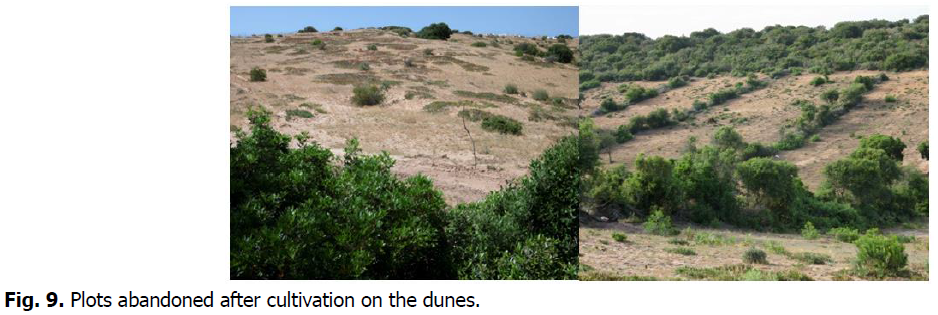
Fig 9: Plots abandoned after cultivation on the dunes.
Consequences of vegetation degradation in the dune cordon
The important role of wind in the study area is revealed by the extent of the dune cordon, which extends approximately 13 km toward the interior of the Sanhadja Plain. The NW and NNW prevailing winds have a clear degrading effect on the dune complex, which blows over dry surfaces and transports sand particles. The hodographs shown in Fig. 10 provide insights into this phenomenon, indicating that sand transport is effective all year round, and is typically performed by N, NW, and NNW prevailing winds, carrying sand in a NW-SE direction during all months of the year. The broken line shows the effect of the changing wind directions and speeds, which peak in winter and are often marked by sand eddies.
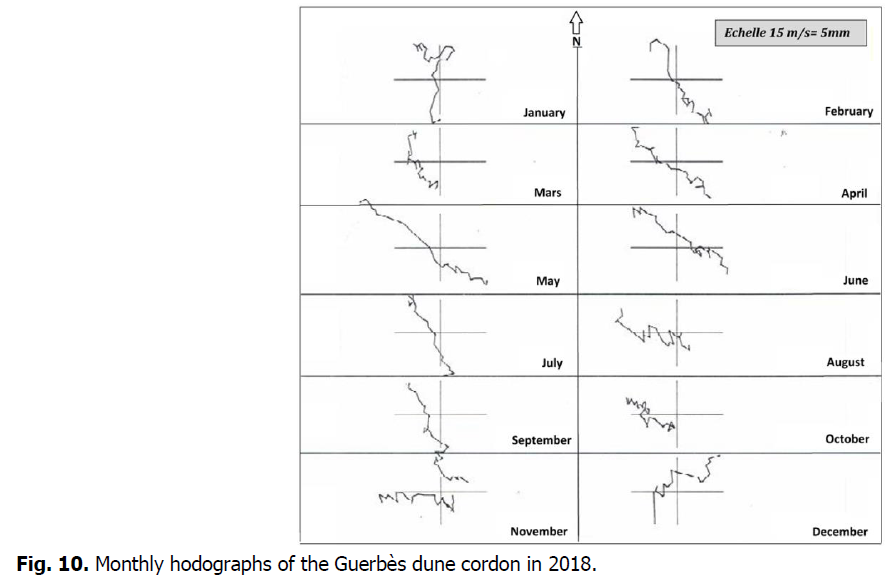
Fig 10: Monthly hodographs of the Guerbès dune cordon in 2018.
Annex 4 shows that the average amount of sand transported to the SE during the winter season, when the soil becomes bare and dry, can reach 768.12 g/m/s on the Guerbès dune ridge. In spring, the winds are strong; however, they develop new micro-dunes with vegetation, resulting in a sand transport rate of up to 192.24 g/m/s. During the summer season, the sands are dry and mobile, and the maximum wind speeds are lower, but still contribute to the mobility of the dunes, with a sand transport rate of only 67.67 g/m/s. In the fall, northerly winds seem to influence the often dry and bare sands, with an estimated sand transport rate of 134.93 g/m/s. To more accurately estimate the amount of sand transported, in situ stations should be employed to measure the daily effective wind speeds.
Insights for vegetation conservation and management of the the Guerbès-Benazouz dune cordon
All vegetation species identified in our field survey were also observed in the littoral region of eastern Algeria by Thomas (1975) and Samraoui, B., and De Belair, G. (1997). Although these species still exist, they have experienced severe anthropic degradation, especially on the dune cordon where evidence of wind erosion has been reported (Bazri, K., 2021). Wind dynamics have a clear degrading effect on dunes that are poorly protected by vegetation. This leads to silting of roads, houses, and villages, and reduces the capacity of lake areas, which leads to a reduction of water levels in protected wetlands, which are also threatened by the pumping of water for crop irrigation. Today, these lacustrine ecosystems suffer from reduced biodiversity of avifauna, and ecological imbalance in terms of insufficient water and food. Lacustrine areas such as garaet Beni Mhammed are home to the following avifauna species: white-headed (Oxyura leucocephala), Ferruginous duck (Aythya nyroca), marbled teal (Marmaronetta angustirostris), Sultana Hen (Porphyrio porphyrio), coot (Fulica atra), great crested grebe (Podiceps cristatusand Tachybaptus ruficollis), moorhen (Gallinula chloropus), and other passerine waterbirds as communicated by Bazri, K. (2021).
Considering the negative consequences of increasing anthropogenic degradation, it is necessary to combat all forms of degradation in the study area, which include sand extraction and land clearing. Mechanical and biological measures of dune fixation involve promoting the regeneration and recovery of pioneer species such as Retama monosperma and Retama boveï in areas that are severely degraded. These two leguminous species seem to tolerate mobile sand dunes well, contribute to enriching organic matter in the substrate, and aid in the recovery of vegetation toward climax Quercus cocciferaforest. Application of the genus Retama for the biological fixation of degraded dunes is supported by previous research on the evolution of flora and vegetation in the Mediterranean Maghreb (Quézel, P., Sur, R., 2002) and the germination of seeds in poor sandy environments in Egypt (Ashraf, 2009). This genus contains psamophilic species that develop nodules, which can enrich nitrogen-poor soils and promote the development of other pioneer species that can fix the dunes. Moreover, this genus is of substantial interest to the plant biotechnology industry and soil stability research (Farchichi, 1996). Furthermore, reforestation should be encouraged by planting native species and crops.
Conclusion
The natural environment of the Guerbès-Benazouz dune cordon in eastern Algeria is characterized by undeveloped and poorly developed mineral soils colonized by groups of Diotis maritime, Ammophila arenaria, Retama boveï, Quercus coccifera, Alnus glutinosa, Pistacia lentiscus, and Quercus suber which are frequently degraded by human activities and reduced scrubland and low bushy formations. Such activities have contributed to degradation of the vegetation cover and soil, which threatens the natural and agri-silvicultural potential of this region characterized by diverse landscapes, including plains, coastal dunes, foothills, lacustrine areas, and marshland. The topography is typically flat (slopes of 0-4%), which hinders the flow of the Kebir West River, and promotes the formation of lakes and swamps.
This region exhibits clear interaction between the geological substratum, soil, climate, and vegetation. The fragility of the lithological structure (sandstone and sand) and the elimination of natural vegetation by human activities (fires, cuttings, clearing, and cultivation) have led to the development of degraded lands exposed to erosive agents. In particular, wind dynamics have a clear impact on the dune landscape, with strong winds (maximum speeds >6 m/s) in the NW-SE direction and a long dry season, as well as a lack of natural obstacles preventing sand transport.
The consequences of ecological imbalance are severe, and impact the stability of the rural population in the study area. Therefore, efforts should be made to prevent or mitigate dune erosion by allowing the vegetation to recover and create a newly balanced ecosystem. However, severely degraded environments require delicate and long-term remediation measures, which should provide immediate protection and permit rational development of the natural environment, which is inseparable from development of the regional and national economy. In this sense, priority should be given to preventing wind erosion through physical defenses and biological fixation via the introduction of Retama boveï, which has substantial potential in terms of adaptation and reproduction.
References
Acosta, A., Stanisci, A., Ercoles, S., Blasi, C. (2003). Sandy coastal landscape of the Lazio region (Central Italy). Phytocoenologia, 33:715-726.
Acosta, A., Ercole, S., Stanisci, A., Pillar, V., Blasi, C. (2007). Coastal vegetation zonation and dune morphology in some mediterranean ecosystems. Journal of Coastal Research, 23:1518-1524.
Aouadi, H. (1989). Végétation de l’Algérie Nord orientale: Histoire des influences anthropiques et cartographie au 1/20.000. Biologie Grenoble I, 108.
Ashraf, M.Y. (2009). Seed germination of some desert plants from Egypt. Journal of Applied Sciences Research, 5:144.
Bazri, K. (1999). Les milieux naturels et leur aménagement dans l’extrême Nord-Est algérien: Cas de Guerbèset Cap-rosa. Thèse Magistère, University Constantine1, Algérie, p:269.
Bazri, K. (2021). La végétation et les ressources en eau dans les écosystèmes: Cas du complexe dunaire de Guerbès-Sanhadja (W. de Skikda). Communication orale. La journée mondiale de l’eau: La Valorisation et l’économie de l’eau. Palais de la Culture Malek Haddad. Constantine.
Boulila, F., Depret, G., Boulila, A., Belhadi, D., Benallaoua, S., Laguerre, G. (2009). Retama species growing in different ecological-climatic areas of northeastern Algeria have a narrow range of rhizobia that form a novel phylogenetic clade within the Bradyrhizobium genus. Systematic and Applied Microbiology, 32:245.
Braun-Blanquet, J. (1951). Les groupements végétaux de la France méditerranéenne. C.N.R.S., Paris, p:297.
Carter, W.G., Richard, W., Peter, W. (1990). The geomorphological, ecological and pedological development of coastal fore dunes at Magilligan Point, Northern Ireland.
Chergui, A., Hafid, E., Melhaoui, M. (2009). Caractéristiques de l’oyat ammophila arenaria, plantes des habitats côtiers du littoral de Saïda (Méditerranée-Maroc). International Workshop on “Integrated Coastal Zone Management” Izmir-Turkey. INOC-IMST Iinternational Workshop ICZM-2009.
Curr, R.H.F., Hoh, A., Edwards, E., Williams, A.T., Davies, P. (2000). Assessing anthropogenic impact on mediterranean sand dunes form aerial digital photography. Journal of Coastal Conservation, 6:15-22.
Cutini, M., Cancellieri, L., Cioffi, M.T., Licursi, C. (2010). Phytosociology and phytogeography of fragmented Alnus glutinosa forests in a Tyrrhenian district (Central Italy). Ecologia Mediterranea, 36:55-73.
Durand, J.H. (1952). Etude géologique, hydrogéologique et pédagogique des croûtes en Algérie. Publicat ion Gouvernement général de l’Algérie. Service colonisation et hydraulique. Birmandreis, Alger, p:203.
Farchichi, A. (1996). La lutte contre l’ensablement et pour la stabilisation des dunes: Essai de la fixation biologique des dunes en Tunisie présaharienne. Review Tunis, 12:49.
Fenu, G., Donatella, C., Concetta, F., Gianluigi, B. (2012). Relationships between coastal sand dune properties and plant community distribution: The case of Is Arenas (Sardinia). Plant Biosystems, 146:586-602.
Géhu, J.M., Biondi, E. (1994a). Végétation du littoral de la Corse. Essai de synthèse phytosociologique. Braun-Blanquetia, 13:1-149.
Guo, Y.Q., Lee, I.B., Hideyuki, S., Yong, G., Guodong, D. (2004). Principles of sand dune fixation with straw checkerboard technology and its effects on the environment. Journal of Arid Environments, 56:449-464.
Hébrard, H. (1977). Contribution à l’étude de la végétation muscinale de quelques formations du maquis corse. Les cistaies sèches et les peuplements à Halimium halimifolium. Ecologia Mediterranea, 3:133.
Hilly, J. (1957). Etude géologique du massif de l’Edough et de Cap de fer (Est constantinois).
Joleaud, L. (1912). Etude géologique du massif de Filfila (Algérie Nord-Oriental). Stratigraphie des unités allochtones: Structures et métamorphismes du massif. Ronéote, Nancy, p:96.
Khalil, A., Belabed, A. (1999). Approche phytoécologique descriptive de dunes fixées par des graminées vivaces au Maroc oriental. Bulletin de l'institut Scientifique. Rabat, 22:81-86.
Marchetti, D. (2004). Le pteridofite d’Italia. Annali del Museo civico di Rovereto, 19:71-231.
Marta, G.S., Vojtěch, B., Marta, C., Alicia, T.R.A. (2020). Getting the measure of the biodiversity crisis in Mediterranean coastal habitats. Journal of Ecology, 109:1224-1235.
Merniz, N., Tahar, A., Benmehaïa, A.M. (2019). Statistical assessment of rainfall variability and trends in northeastern Algeria. Journal of Water and Land Development, 40:87.
Oldache, E.H. (2021). Le barrage vert: Bilan physique et perspectives. Annales de la Recherche Forestière en Algérie, 11:7-20.
Paskoff, R. (2005). Caractérisation et gestion d’un type de dune littorale: Les avants dunes. Sécheresse, 16:247.
Quézel, P., Santa, S. (1962). Nouvelle flore de l’Algérie et des régions désertiques méridionales. CNRS, Paris, 2:1170.
Quézel, P., Sur, R. (2002). L’évolution de la flore et de la végétation au Maghreb méditerranéen, p:112.
Rapport des Nations Unies sur le Sommet Planète Terre (1992). Rio de janeiro: Organisation des Nations Unies, p:50.
Samraoui, B., De Belair, G. (1997). The guerbès-sanhadja wetlands (N.E. Algeria). Part I: An Overiew. Ecologie. 1:233-250.
Svintsov, I. (1986). Etude de la déflation et du transport de sable. In Principes et méthodes de fixation des sables mouvants, Commission de l’URSS, pour le P.N.U.E, p:92.
Tayeb, S., Khéloufi, B. (2008). Contribution to the study of land-use dynamics in the plains of Macta (Algeria) with the aid of remote sensing and GIS. Comptes Rendus Biologiques, 331:466-474.
Thomas, S.Y. (1975). Ecologie et dynamique de la végétation des dunes de Jijel à Elkala (Est algérien). Thèse Doctorat en Ecologie Végétale University Science Et Technology Languedoc, p:132.
Tricard, J. (1968). Précis de géomorphologue. Dynamique générale. Paris, Cedex, p:345.
Van der Maarel, E. (2003). Some remarks on the functions of European coastal ecosystems. Phytocoenologia, 33:187-202.
Villa, J.M. (1982). La chaîne alpine d’Algérie orientale et des confins algéro-tunisien. Thèse Science, Paris, p:665.
Wael, E.Z. (2014). Diachronic study of the forest cover regression in the Telagh plain (Algeria): approach by remote sensing and GIS. Bulletin de l'Institut Scientifique, Rabat, Section Sciences de la Vie, 36:25-31.
Author Info
B. Kamel-Eddine*Citation: Kamel-Eddine, B. (2022). Vegetation and landscape dynamics of the Guerbes-Benazouz dune cordon in Skikda, Algeria. Ukrainian Journal of Ecology. 12:36-45.
Received: 19-Feb-2022, Manuscript No. UJE-22-54940; Accepted: 14-Mar-2022, Pre QC No. P-54940; Editor assigned: 22-Feb-2022, Pre QC No. P-54940; Reviewed: 28-Feb-2022, QC No. Q-54940; Revised: 05-Mar-2022, Manuscript No. R-54940; Published: 26-Mar-2022, DOI: 10.15421/2022_352
Copyright: This is an open access article distributed under the terms of the Creative Commons Attribution License, which permits unrestricted use, distribution, and reproduction in any medium, provided the original work is properly cited.
